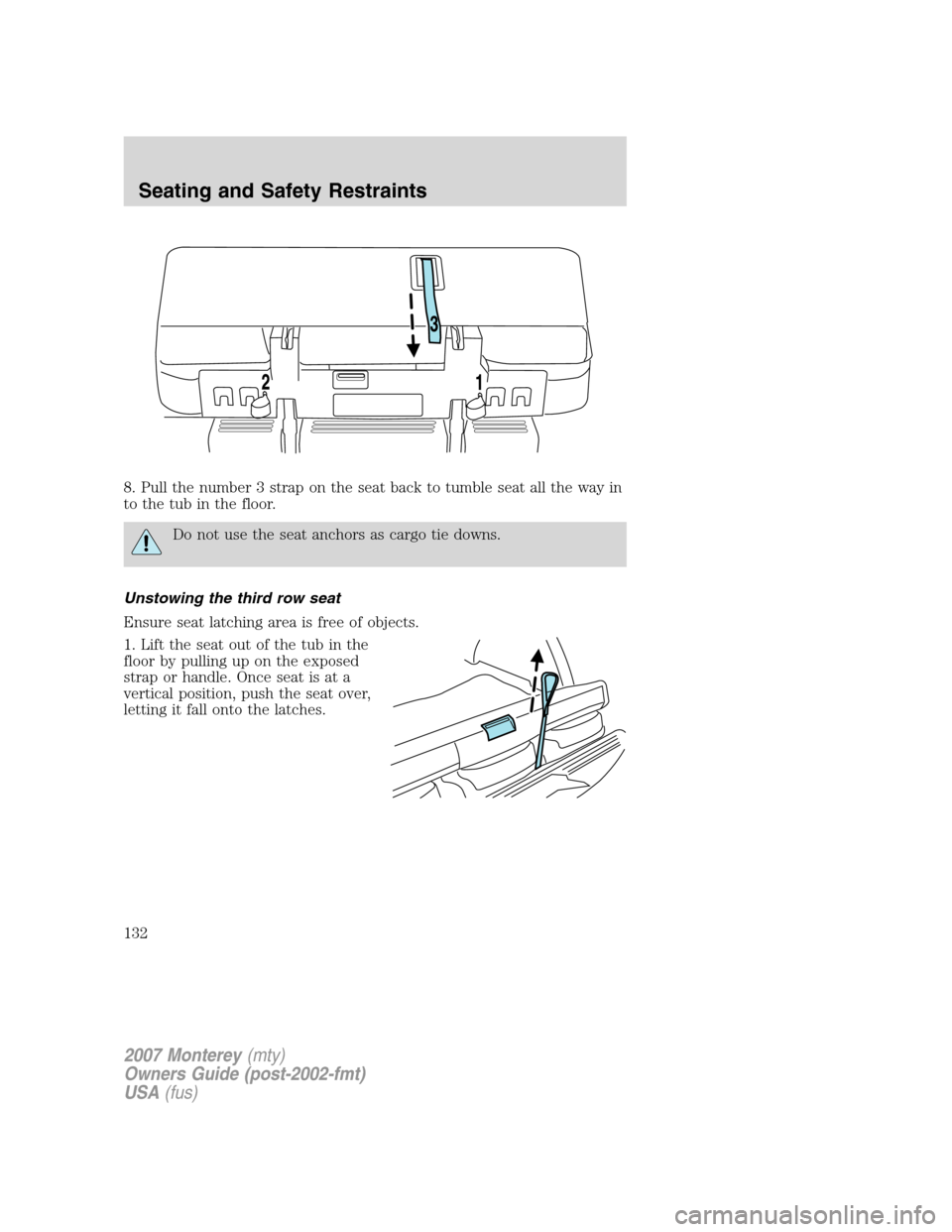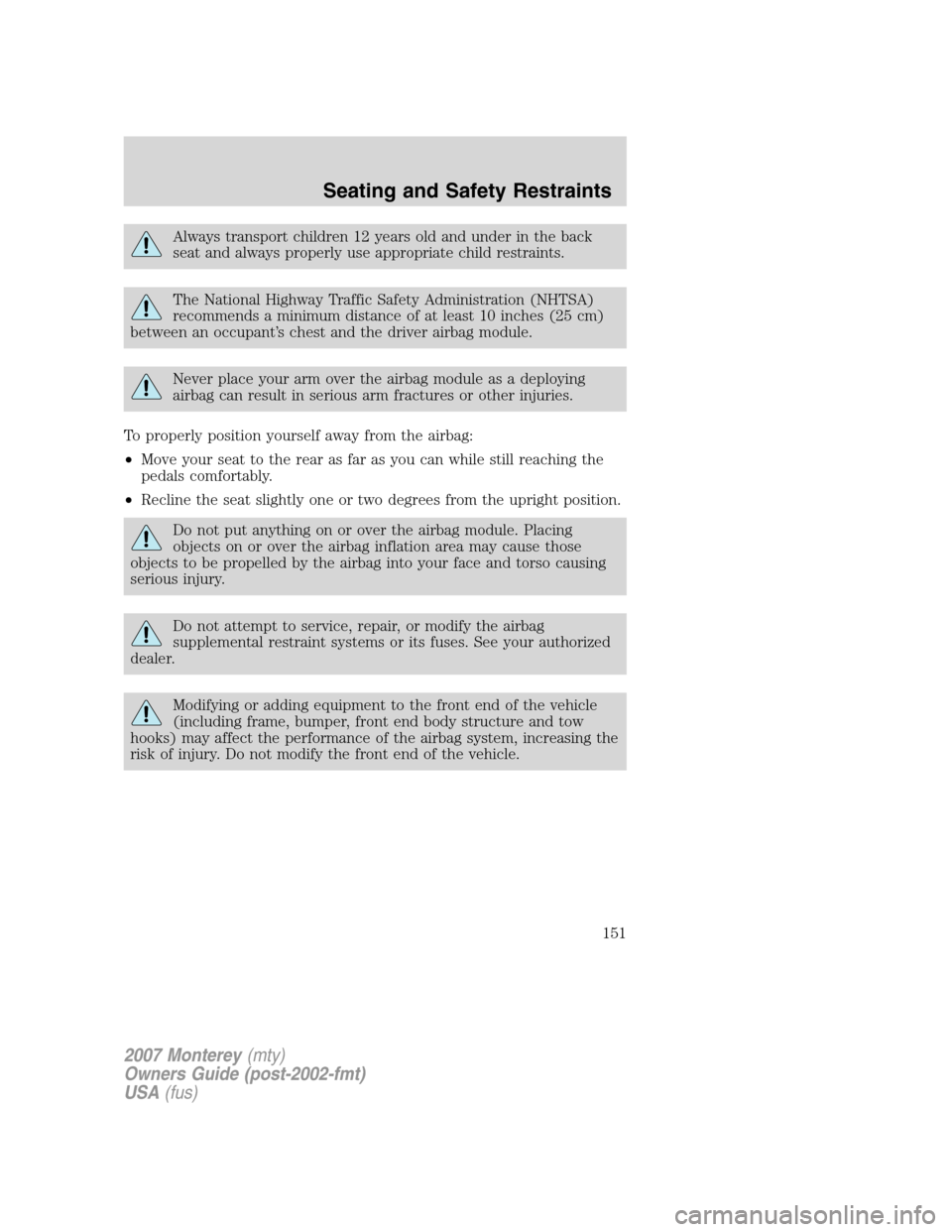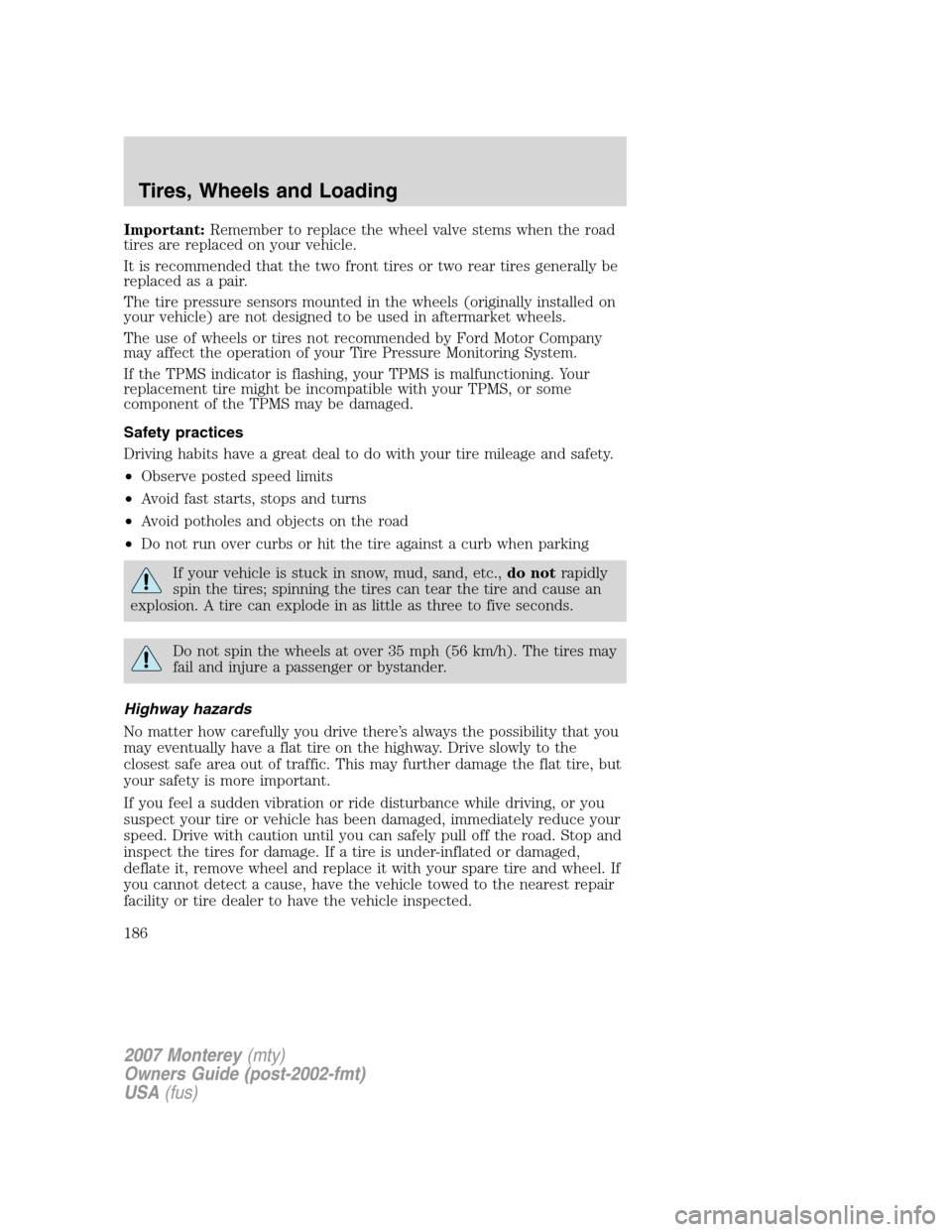tow Mercury Monterey 2007 s Owner's Guide
[x] Cancel search | Manufacturer: MERCURY, Model Year: 2007, Model line: Monterey, Model: Mercury Monterey 2007Pages: 312, PDF Size: 3.57 MB
Page 132 of 312

8. Pull the number 3 strap on the seat back to tumble seat all the way in
to the tub in the floor.
Do not use the seat anchors as cargo tie downs.
Unstowing the third row seat
Ensure seat latching area is free of objects.
1. Lift the seat out of the tub in the
floor by pulling up on the exposed
strap or handle. Once seat is at a
vertical position, push the seat over,
letting it fall onto the latches.
2007 Monterey(mty)
Owners Guide (post-2002-fmt)
USA(fus)
Seating and Safety Restraints
132
Page 134 of 312

Reclining the seatback can cause an occupant to slide under the
seat’s safety belt, resulting in severe personal injuries in the
event of a collision.
Tailgate function
The 3rd row seat is equipped with a tailgate function to be utilized when
the vehicle is parked and engine turned off. This rearward-facing position
allows the customer to open the liftgate and sit facing out of the vehicle
rearward.
This is not a position suitable for driving. Do not drive the
vehicle with the seat in this position. The safety belts are not
functional when the seat is in the tailgate position.
Ensure head restraints are moved to their full down position, all safety
belts are released from the seat, seat and stowage tub are free of objects.
1. Push the head restraint release buttons and move all head restraints
fully down.
2. To access the tailgate function,
the seat must be in the seating
position. If the seat is not in the
seating position, follow all the steps
of theUnstowing the third row
seat section.Once the seat is in the
seating position, release the cushion
latches by pulling the number 2
strap. Then, pull the seat rearward
by the number 3 strap and set the
seat on the liftgate scuff plate. The
number 1 strap is not used to
access this position.
Do not sit on the head restraints.
2
2007 Monterey(mty)
Owners Guide (post-2002-fmt)
USA(fus)
Seating and Safety Restraints
134
Page 143 of 312

Position the safety belt height adjusters so that the belt rests
across the middle of your shoulder. Failure to adjust the safety
belt properly could reduce the effectiveness of the safety belt and
increase the risk of injury in a collision.
Third row comfort guide
Note:Before stowing the third row seat or folding the third row seat
back down, the center seat lap/shoulder belt needs to either have the
cross lap tongue stowed in the pocket on the belt or the entire belt
needs to be stowed in the roof.
The safety belt for the 3rd row
center occupant may be stowed in
the ceiling if it has been detached
from the seat to carry large cargo.
Remove the safety belt from the
stowage area on the ceiling and
buckle the small tongue on the end
of the safety belt to the mini-buckle
on the left side of the center seat
position.
The third row center lap/shoulder
belt is equipped with a Belt Comfort
Guide located in a pocket on the
back of the seat. The guide is
attached to the driver’s side head
restraint, and is used to adjust the
comfort of the shoulder belt for
smaller occupants in the center
position of the 3rd row seat. To
adjust the comfort guide:
•Slip the shoulder belt into the
belt guide.
•Slide the guide up or down along the head restraint post so that the
belt is centered on the occupant’s shoulder.
Safety belt extension assembly
If the safety belt is too short when fully extended,a9inch(23cm)or
12 inch (31 cm) safety belt extension assembly can be added (part
numbers 611C22–A and 611C22–B respectively). These assemblies can
be obtained from an authorized dealer.
2007 Monterey(mty)
Owners Guide (post-2002-fmt)
USA(fus)
Seating and Safety Restraints
143
Page 151 of 312

Always transport children 12 years old and under in the back
seat and always properly use appropriate child restraints.
The National Highway Traffic Safety Administration (NHTSA)
recommends a minimum distance of at least 10 inches (25 cm)
between an occupant’s chest and the driver airbag module.
Never place your arm over the airbag module as a deploying
airbag can result in serious arm fractures or other injuries.
To properly position yourself away from the airbag:
•Move your seat to the rear as far as you can while still reaching the
pedals comfortably.
•Recline the seat slightly one or two degrees from the upright position.
Do not put anything on or over the airbag module. Placing
objects on or over the airbag inflation area may cause those
objects to be propelled by the airbag into your face and torso causing
serious injury.
Do not attempt to service, repair, or modify the airbag
supplemental restraint systems or its fuses. See your authorized
dealer.
Modifying or adding equipment to the front end of the vehicle
(including frame, bumper, front end body structure and tow
hooks) may affect the performance of the airbag system, increasing the
risk of injury. Do not modify the front end of the vehicle.
2007 Monterey(mty)
Owners Guide (post-2002-fmt)
USA(fus)
Seating and Safety Restraints
151
Page 157 of 312

ObjectsPass Airbag Off
Indicator LampPassenger Airbag
Small (i.e. 3 ring
binder, small purse,
bottled water)Unlit Disabled
Medium (i.e. heavy
briefcase, fully packed
luggage)Lit Disabled
Empty seat, or small
to medium object with
safety belt buckledLit Disabled
If you think that the status of the passenger airbag off indicator lamp is
incorrect, check for the following:
•Objects lodged underneath the seat
•Objects between the seat cushion and the center console (if
equipped)
•Objects hanging off the seat back
•Objects stowed in the seatback map pocket (if equipped)
•Objects placed on the occupant’s lap
•Cargo interference with the seat
•Other passengers pushing or pulling on the seat
•Rear passenger feet and knees resting or pushing on the seat
The conditions listed above may cause the weight of a properly seated
occupant to be incorrectly interpreted by the passenger sensing system.
The person in the front passenger seat may appear heavier or lighter due
to the conditions described in the list above.
To reduce the risk of possible serious injury:
Do not stow objects in seat back map pocket (if equipped) or
hang objects off seat back if a child is in the front passenger seat.
Do not place objects underneath the front passenger seat or between
the seat and the center console (if equipped).
Check the “passenger airbag off” or “pass airbag off” indicator lamp for
proper airbag status.
Failure to follow these instructions may interfere with the front
passenger seat sensing system.
2007 Monterey(mty)
Owners Guide (post-2002-fmt)
USA(fus)
Seating and Safety Restraints
157
Page 168 of 312

Move a child to a different seating location if the shoulder belt
does not stay positioned on the shoulder during use.
Follow all instructions provided by the manufacturer of the
booster seat.
Never put the shoulder belt under a child’s arm or behind the
back because it eliminates the protection for the upper part of
the body and may increase the risk of injury or death in a collision.
Never use pillows, books, or towels to boost a child. They can
slide around and increase the likelihood of injury or death in a
collision.
SAFETY SEATS FOR CHILDREN
Child and infant or child safety seats
Use a safety seat that is recommended for the size and weight of the
child. Carefully follow all of the manufacturer’s instructions with the
safety seat you put in your vehicle. If you do not install and use the
safety seat properly, the child may be injured in a sudden stop or
collision.
2007 Monterey(mty)
Owners Guide (post-2002-fmt)
USA(fus)
Seating and Safety Restraints
168
Page 170 of 312

Installing child safety seats with combination lap and shoulder
belts
Airbags can kill or injure a child in a child seat.NEVERplace a
rear-facing child seat in front of an active airbag. If you must use
a forward-facing child seat in the front seat, move the seat all the way
back.
Children 12 and under should be properly restrained in the rear
seat whenever possible.
1. Position the child safety seat in a
seat with a combination lap and
shoulder belt.
If you use the 3rd row center seat
and the safety belt has been
detached from the seat to carry
large cargo, remove the safety belt
from the stowage area on the ceiling
and buckle the small tongue on the
end of the belt to the mini-buckle
on the left side of the center seat
position.
2. Pull down on the shoulder belt
and then grasp the shoulder belt
and lap belt together.
2007 Monterey(mty)
Owners Guide (post-2002-fmt)
USA(fus)
Seating and Safety Restraints
170
Page 172 of 312

7. Pull the lap belt portion across
the child seat toward the buckle and
pull up on the shoulder belt while
pushing down with your knee on the
child seat.
8. Allow the safety belt to retract to
remove any slack in the belt.
9. Before placing the child in the
seat, forcibly move the seat forward
and back to make sure the seat is
securely held in place. To check
this, grab the seat at the belt path
and attempt to move it side to side
and forward. There should be no
more than one inch of movement for
proper installation.
10. Try to pull the belt out of the retractor to make sure the retractor is
in the automatic locking mode (you should not be able to pull more belt
out). If the retractor is not locked, unbuckle the belt and repeat Steps
two through nine.
Check to make sure the child seat is properly secured before each use.
Attaching child safety seats with tether straps
Most new forward-facing child safety seats include a tether strap which
goes over the back of the seat and hooks to an anchoring point. Tether
straps are available as an accessory for many older safety seats. Contact
the manufacturer of your child seat for information about ordering a
tether strap.
Children should be placed in the rear in an appropriate child
safety seat that is properly secured to the vehicle.
2007 Monterey(mty)
Owners Guide (post-2002-fmt)
USA(fus)
Seating and Safety Restraints
172
Page 186 of 312

Important:Remember to replace the wheel valve stems when the road
tires are replaced on your vehicle.
It is recommended that the two front tires or two rear tires generally be
replaced as a pair.
The tire pressure sensors mounted in the wheels (originally installed on
your vehicle) are not designed to be used in aftermarket wheels.
The use of wheels or tires not recommended by Ford Motor Company
may affect the operation of your Tire Pressure Monitoring System.
If the TPMS indicator is flashing, your TPMS is malfunctioning. Your
replacement tire might be incompatible with your TPMS, or some
component of the TPMS may be damaged.
Safety practices
Driving habits have a great deal to do with your tire mileage and safety.
•Observe posted speed limits
•Avoid fast starts, stops and turns
•Avoid potholes and objects on the road
•Do not run over curbs or hit the tire against a curb when parking
If your vehicle is stuck in snow, mud, sand, etc.,do notrapidly
spin the tires; spinning the tires can tear the tire and cause an
explosion. A tire can explode in as little as three to five seconds.
Do not spin the wheels at over 35 mph (56 km/h). The tires may
fail and injure a passenger or bystander.
Highway hazards
No matter how carefully you drive there’s always the possibility that you
may eventually have a flat tire on the highway. Drive slowly to the
closest safe area out of traffic. This may further damage the flat tire, but
your safety is more important.
If you feel a sudden vibration or ride disturbance while driving, or you
suspect your tire or vehicle has been damaged, immediately reduce your
speed. Drive with caution until you can safely pull off the road. Stop and
inspect the tires for damage. If a tire is under-inflated or damaged,
deflate it, remove wheel and replace it with your spare tire and wheel. If
you cannot detect a cause, have the vehicle towed to the nearest repair
facility or tire dealer to have the vehicle inspected.
2007 Monterey(mty)
Owners Guide (post-2002-fmt)
USA(fus)
Tires, Wheels and Loading
186
Page 195 of 312

no longer capable of functioning as intended. Please refer to the
following chart for information concerning your Tire Pressure Monitoring
System:
Low Tire Pressure
Warning LightPossible cause Customer Action Required
Solid Warning Light Tire(s)
under-inflated1. Check your tire pressure to
ensure tires are properly
inflated; refer toInflating
your tiresin this chapter.
2. After inflating your tires to
the manufacturer’s
recommended inflation
pressure as shown on the Tire
Label (located on the edge of
driver’s door or the B-Pillar),
the vehicle must be driven for
at least two minutes over
20 mph (32 km/h) before the
light will turn OFF.
Spare tire in use Your temporary spare tire is in
use. Repair the damaged road
wheel/tire and reinstall it on
the vehicle to restore system
functionality. For a description
on how the system functions,
refer toWhen your temporary
spare tire is installedin this
section.
TPMS
malfunctionIf your tires are properly
inflated and your spare tire is
not in use and the light
remains ON, have the system
inspected by your authorized
dealer.
2007 Monterey(mty)
Owners Guide (post-2002-fmt)
USA(fus)
Tires, Wheels and Loading
195